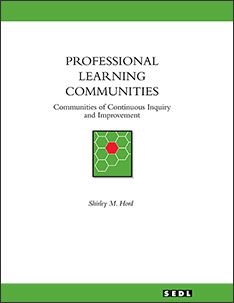In Conclusion
This review and synthesis of the literature on learning communities represents the work of highly reputed educational researchers in the fields of teaching and learning, and school change processes. Through defining characteristics and operational procedures, these researchers have helped us to understand more about these communities. Further, the research is clear about the significant outcomes for both staff and students that result from professional organization arrangements such as these. Admittedly, what the researchers have not given us is guidance about initiating and developing such structures - a necessary next step.
Nonetheless, the mandate from these writers is to move forward. Emily Calhoun (1994) argued that "the results of our study make us intolerant of the status quo that allows the loss of a million students a year, with disenfranchisement from the opportunities our society offers" (p. 3). In a large way, there is a sufficient knowledge base to guide the appropriate and effective learning experiences of all students. Encouraging educators to take the necessary action to learn how to build on their strengths has been problematic. However, a bright spot is provided by the number of reports in the literature that focus on collaborative learning activities and the concept of learning communities being designed and implemented in various teacher and administrator preparation programs in higher education (Gamson, 1994; Avila et al., 1995; Matthews, 1995).
Sergiovanni (1996) maintained that classrooms must become communities of learning, caring, and inquiring. For this to happen, the school must become a place where teachers are involved in a community of learning, caring, and inquiring. "Key to community in both classrooms and schools is a commitment to inquiry, and a commitment to learning as the basis for decisions" (p. 147). "If our aim is to help students become lifelong learners by cultivating a spirit of inquiry and the capacity for inquiry, then we must provide the same conditions for teachers" (p. 52). Educator preparation programs can help to bring about these conditions.
As mentioned in the introduction to this literature review, many approaches have been offered in the hope that school staffs will gain sufficient knowledge and skills to provide the effective learning experiences that all students need in order to become successful learners. The message of this review seems abundantly clear: Professional learning communities can increase staff capacity to serve students, but success depends on what the staff do in their collective efforts. Peterson and colleagues (1996) caution that "while school structures can provide opportunities for learning new practices, the structures, by themselves, do not cause the learning to occur" (p. 119).
Whether schools organized in this way are labeled learning organizations, learning communities, professional learning communities, professional schools, problem-solving schools, or communities of continuous inquiry and improvement, it is important to keep in mind that what is now envisioned is a quantum leap toward the creation of a setting where inquiry is normal and the conditions of the workplace support continuous, collegial inquiry . . . that involves the total faculty, builds community, serves to increase student learning through the study of instruction and curriculum, and seeks to provide a nurturant organization through collective study of the health of the school (Joyce & Calhoun, 1995, p. 51).
Next Page: References

